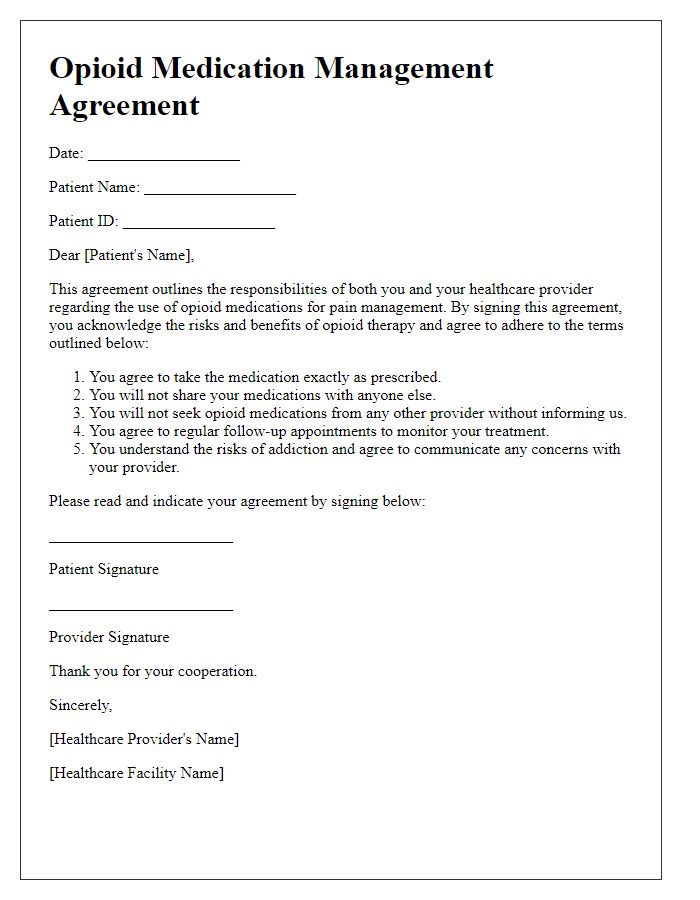Are you concerned about managing opioid prescriptions effectively and responsibly? Navigating the complexities of opioid use can be challenging, and having a clear monitoring agreement can make a world of difference. This type of agreement helps to ensure patient safety, improve communication, and promote accountability for both patients and healthcare providers. Ready to dive deeper into the benefits of an opioid usage monitoring agreement? Read on!

Patient Consent and Acknowledgment
In an opioid usage monitoring agreement, such as a Patient Consent and Acknowledgment form, patients will typically agree to specific parameters regarding their opioid prescriptions to prevent misuse. This documentation often includes details like patient identification (full name, date of birth), the name of the prescribing healthcare provider (doctor's name, medical practice), and the specific opioid medications being prescribed (brand names, dosage). The agreement may outline the patient's responsibilities, including adhering to the prescribed dosage, attending regular follow-up appointments (typically scheduled every 30 to 90 days), and submitting to urine drug screenings to monitor compliance. Patients acknowledge understanding of the risks associated with opioid therapy, such as addiction or overdose, which requires informed consent. Additionally, there may be stipulations regarding the storage of medications to prevent unauthorized access, along with consequences for failing to comply with the agreement or seeking opioids from multiple providers, known as "doctor shopping.
Medication List and Dosage Schedule
Opioid usage monitoring agreements are crucial documents in managing patients prescribed opioid medications, specifically hydrocodone, oxycodone, and morphine. The agreement outlines a detailed medication list, specifying each medication's dosage schedule, essential for ensuring patient adherence and safety. For instance, hydrocodone, often prescribed for severe pain relief, typically comes in 5 mg or 10 mg tablets taken every 4 to 6 hours, while oxycodone may be prescribed in 10 mg doses every 12 hours. Morphine, a potent opioid, can be dosed in various forms, including extended-release tablets of 15 mg taken twice daily for chronic pain management. This structured approach helps in monitoring for potential misuse and adjusting treatment plans as necessary, fostering better outcomes for patients dealing with pain management.
Risks and Side Effects Disclosure
Monitoring agreements for opioid use are critical for patient safety and responsible prescribing practices. Opioids, including Morphine and Oxycodone, can lead to significant side effects such as respiratory depression, particularly at dosages exceeding the 50 milligram morphine equivalent daily, which increases overdose risks. Patients must be informed about withdrawal symptoms, addiction potential, and the necessity for regular check-ins with healthcare providers every 30 days. Moreover, concurrent use of benzodiazepines can amplify sedation effects, elevating the risk of accidental overdose. Ensuring patients understand these risks fosters a collaborative approach to pain management and promotes adherence to prescribed regimens while safeguarding against misuse and potential legal ramifications.
Responsibilities and Compliance
The Opioid Usage Monitoring Agreement outlines the responsibilities and compliance expectations for patients prescribed opioid medications, such as Morphine or Oxycodone, to manage pain effectively while minimizing the risk of misuse or addiction. Patients must adhere to dosage instructions provided by healthcare professionals to avoid potential side effects, including respiratory depression, which can be life-threatening. Regular appointments every 30 days are required to assess treatment efficacy and monitor any adverse reactions. Random drug screenings may be implemented to ensure accountability and compliance with prescribed therapies. Additionally, patients are encouraged to maintain open communication with their healthcare providers regarding any concerns related to opioid use or changes in their health status, promoting a safer approach to pain management.
Review and Monitoring Plan
Opioid usage monitoring agreements are essential for ensuring safe and responsible use of prescription medications, particularly opioids such as morphine and oxycodone. These agreements typically outline the expectations for patient behavior, including adherence to prescribed dosages and schedules. Regular reviews, often occurring every three months, involve assessments of patient progress and the effectiveness of the pain management plan. Healthcare providers may require periodic urine drug screenings to verify compliance with the prescribed regimen, identifying potential misuse or unauthorized medication intake. Additionally, educational resources regarding the risks of opioid addiction and an emergency response plan for overdose situations, including the use of naloxone, are often discussed during the monitoring sessions. This comprehensive approach aims to minimize risks while maximizing patient safety and therapeutic outcomes.













Comments